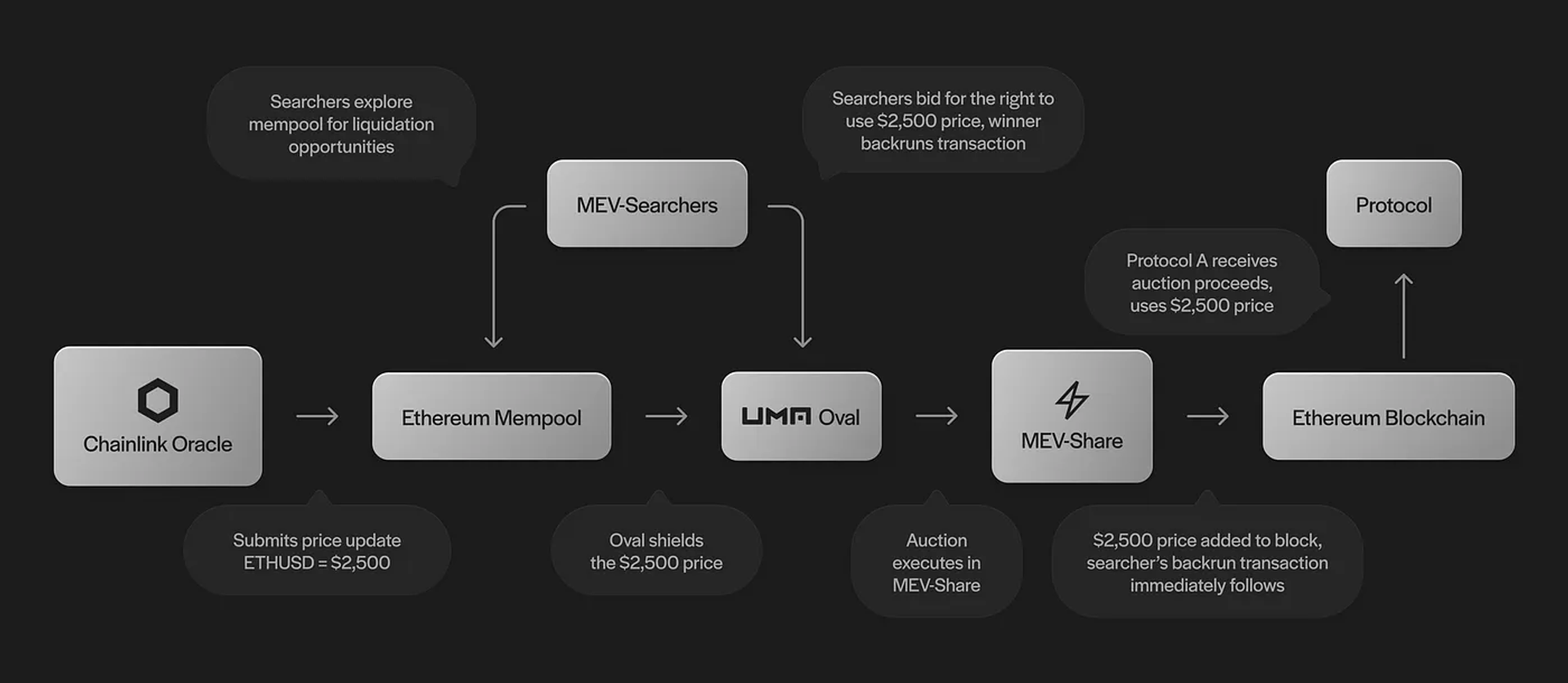The first OEV (Oracle Extractable Value) has been captured in Ethereum by Oval. This means the profits previously captured by searchers from oracle price updates can now be captured by DeFi dapps. This could open up a new revenue source for dapps that was previously captured at the infrastructure level.
The way dapps capture value is changing. They are building their own rollup or appchain, launching their tokens, and implementing additional measures to capture revenue for token holders. Although not many protocols have built effective profit-sharing models for token holders and for themselves, initiatives like OEV are a great approach to creating sustainable business models.
OEV is a specific type of Maximal Extractable Value (MEV) that arises from the updates provided by oracles, which are essential for supplying external data such as asset prices to blockchain-based smart contracts. OEV is generated when there is a time lag between the oracle's price update and the market's response, creating opportunities for searchers to exploit this information asymmetry for profit. This value leakage can be significant, especially in DeFi protocols where timely and accurate price feeds are crucial for functions like liquidations and arbitrage.

Source: Announcing Oval: Earn Protocol Revenue by Capturing Oracle MEV
The diagram illustrates the process of OEV extraction and distribution in the Ethereum. This process ensures that MEV opportunities from oracle feed are efficiently captured and distributed. Here is a step-by-step breakdown:
Chainlink Oracle submits a price update to the Ethereum Mempool, e.g., ETH/USD = $2,500.
Ethereum Mempool receives the price update and holds it temporarily.
MEV-Searchers explore the mempool for liquidation opportunities. They bid for the right to use the $2,500 price update. The highest bidder wins and backruns the transaction.
UMA Oval shields the $2,500 price update. Executes an auction within MEV-Share.
With MEV-Share, the auction proceeds are received by Protocol A. The $2,500 price update is added to the block, and the searcher's backrun transaction follows immediately.
The transaction is added to Etherereum blockchain, and the revenue is shared.
Several projects are actively working on capturing OEV:
Oval, developed by UMA in collaboration with Flashbots, aims to capture OEV by auctioning the right to access oracle data updates, thereby allowing protocols to retain and profit from this value rather than losing it to external actors.
API3 is building an OEV network as a Layer2, built with Polygon zkEVM that focuses on creating a market for oracle updates, enabling more timely and accurate data provision and providing additonal revenue to protocols.
Pyth Network is another project that has the potential to provide OEV for projects. it has a pull-based oracle mechanism that can create a unique opportunity for OEV by giving applications more control over how and when they incorporate price updates. Unlike push-based systems where the transaction space following an oracle update is highly contested, Pyth's pull model allows applications to request price updates on-demand. This design could enable protocols to implement custom MEV extraction or redistribution systems.
Dapps are looking for new ways to generate additional revenue, rather than letting it be captured at the infrastructure level. Some experimental approaches include launching their own Layer2, appchains, and front-end fees. The primitives of DeFi are now sufficient, and current efforts focus on capturing missed revenue opportunities and making protocols more sustainable. The strategy for building DeFi is changing.
Especailly on OEV, this development could lead to a more sustainable and efficient DeFi ecosystem, where value is not lost to third-party searchers but is instead used to benefit the protocol and its participants. As the technology and mechanisms for capturing OEV mature, it is anticipated that more DeFi projects will adopt these solutions.
Source: Unlocking DeFi Revenue by Maximizing OEV for Protocols
Source: Phil Daian (Cornell) "MEV Wat Do"
“At Flashbots, we’ve long held the view that dapps can drastically limit the amount of MEV they expose,” says Hasu, Strategy Lead for Flashbots. “The key insight is that, instead of blindly broadcasting a transaction to the public mempool, protocols should auction off the right to execute this transaction to a competitive market of searchers. Oval is building on that insight to finally return Oracle-Extractable Value (OEV) back to Defi protocols and their users. We look forward to supporting them on that journey.”
If the market recognizes the stable profitability from OEV, there is a possibility that OEV-based yield-bearing tokens could be incorporated as collateral for synthetic assets, similar to how veCRV or LRT-backed synthetic assets in the past. This idea might still be more of a speculation at this point, but it opens up intriguing possibilities for DeFi token. The potential for OEV to serve as a reliable collateral could significantly enhance the robustness and appeal of synthetic assets, providing a new layer of profitability for investors.
UMA - Announcing Oval: Earn Protocol Revenue by Capturing Oracle MEV
Multicoin Capital - Oracles and the New Frontier for Application-Owned Orderflow Auctions
Decentrlized co - Unlocking DeFi Revenue by Maximizing OEV for Protocols
Flashbots - Introduction to MEV Share
Dive into 'Narratives' that will be important in the next year